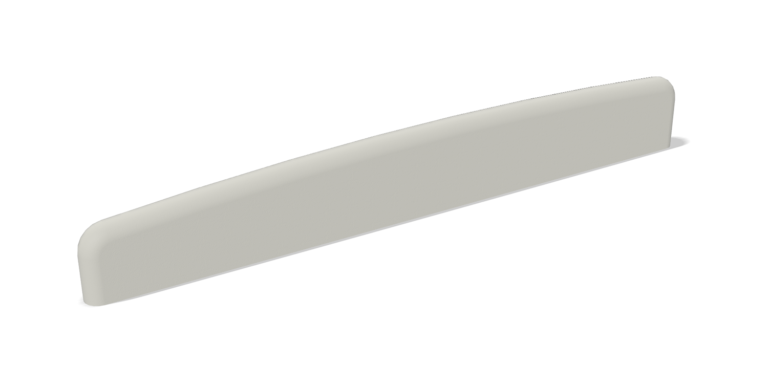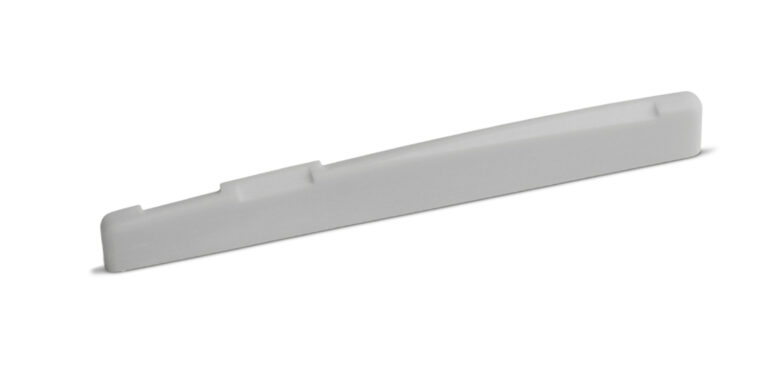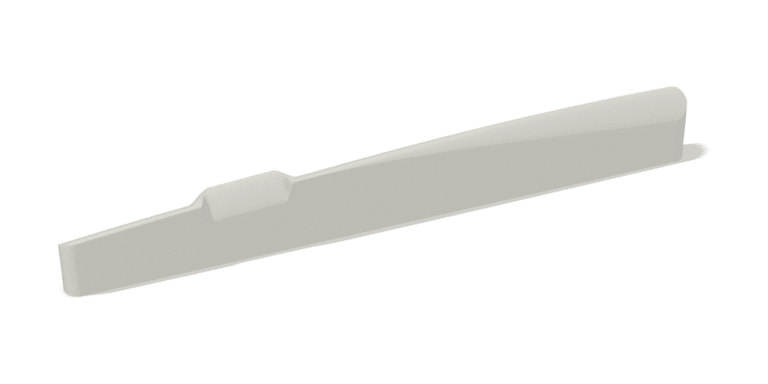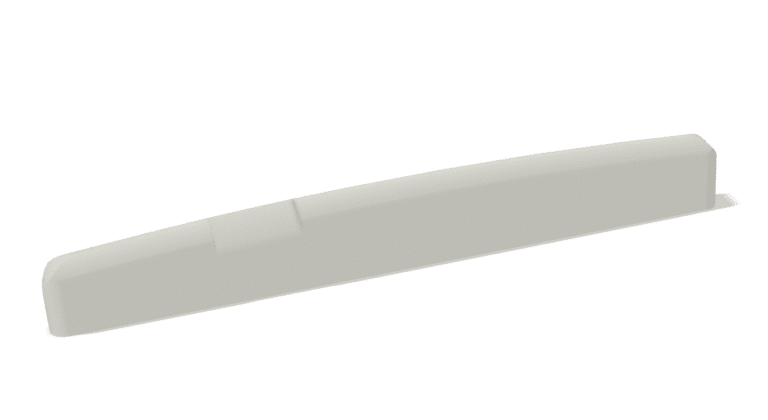Find the Right Saddle for Your Yamaha® Acoustic Guitar
Please Note: This article is only for Yamaha steel string guitars. Yamaha nylon string guitars use different saddle sizes.
Are you in need of a Yamaha steel string acoustic guitar saddle? Yamaha has made steel string acoustic guitars for well over half a century, and has used numerous different saddle sizes and compensation patterns during that time. This makes finding the correct saddle for your Yamaha as there’s no single saddle size.
This article provides tips on finding the right saddle for your Yamaha steel string acoustic guitar, but we suggest that you also measure your guitar’s saddle slot for a proper fit. If you are not the original owner, at some point someone may have installed a different saddle or have adjusted the saddle slot, producing different specs from the factory’s.
Note: You can look up saddle information on Yamaha Parts List Search for your specific model and year. However, please note that this site often lists the closest saddle size and type that Yamaha currently has available, not necessarily the saddle originally used from the factory. As such, we advise that you also follow the below steps to help determine which size is needed.
Step One: Determine Saddle Radius, Length, Thickness, Height
Yamaha steel string acoustic guitars typically have a 400 mm (15.75”) fretboard radius. Please note that if you are not the original owner, another neck may have been installed at some point. You may want to check the fretboard radius with a gauge.
Saddle length will vary significantly, though, depending on year and model. We’ve seen Yamaha steel string saddles anywhere from 72 to 84 mm long, although they often run around 75 to 77 mm. We advise that you also measure your saddle slot as many older Yamahas have saddles that are shorter than the slot.
Thickness will also vary significantly, and can be as thin as 2.5 mm or as thick as 3.5 mm. Yamaha saddles are typically in the 2.9 to 3.1 mm thickness range, though.
Maximum height is typically around 9 to 10 mm, but can be much lower or taller.
Step Two: Determine Saddle Type
Yamaha steel-string acoustics often have one of the following saddle types.
Center Line Non-Compensated Saddle

Almost all Yamaha models made in the 1960s through the 1990s came with a center line non-compensated saddle. A large number of models made after 2000, including some current models, also come from the factory with a non-compensated saddle, too. Please see our Guide to Non-Compensated Saddles for more information.
Yamaha offers a non-compensated resin saddle, part number QA079000, which will fit some models, but please measure your current saddle and saddle slot before ordering. Please see our Non-Compensated Saddle for Yamaha Guitars – 75 mm Length for a similar option in bone.
Finding a quality, appropriately sized non-compensated saddle for older Yamahas can be difficult, as many older Yamaha saddles are quite long – longer than 80 mm. You can visit the Yamaha Vintage FG boards, or contact us.
It might seem as though replacing your Yamaha’s original non-compensated saddle with a B compensated with slanted bass saddle (discussed later) would be an improvement. However, we often advise against this. Yamaha has often used a very sharp bridge saddle slot angle along with a center line non-compensated saddle, rather than a compensated saddle. Placing a compensated saddle on a guitar designed to use a non-compensated saddle can have a negative impact on intonation. Increased compensation does not necessarily equal improved intonation. You should only use a compensated saddle in place of a non-compensated saddle if there are specific intonation issues you with to address.
Let’s look at two images to illustrate this. First is a center line non-compensated saddle at a five degree saddle slot angle, followed by a B compensated with slanted bass saddle at a three degree saddle slot angle. Both images are looking down on the saddle tops. The thin blue line shows approximately where each string sits on the saddle top, but this will vary depending on bridge string spacing.


With a center line non-compensated saddle, all the strings sit in the center on the saddle top. However, the sharper five degree saddle slot angle serves as a form of compensation itself, by making each string from the treble side to the bass side progressively longer.
With a B compensated with slanted bass saddle at a three degree saddle slot angle, the D string also sits in the center of the saddle; however, notice that the treble e and G strings sit forward toward the soundhole, while the B, A, and bass E strings sit back further toward the bridge pins. Because of this compensation difference, replacing a center line non-compensated saddle with a B compensated with slanted bass saddle will affect intonation on several strings, not just the B. While you might improve intonation for some strings, it may worsen it for others.
B Compensated with Slanted Bass – 75 mm Length

A large number of Yamahas made after 2000 have a 75 mm long B compensated with slanted bass resin saddle. The Yamaha factory part number is WT83730E, and Yamaha lists the specs for this part as 75 x 3 x 10 mm. Please note that saddle height will vary, though, even from the factory, for each guitar. However, height for models without undersaddle pickups is often around 10 mm. Models with undersaddle pickups often have saddles around 9 mm tall. Additionally, Yamaha saddle slots typically vary from 2.9 to 3.1 mm, so please measure your saddle slot thickness.
B Compensated with Slanted Bass – 76.72 mm Length

Center Line B Compensated
Some Yamaha models have a thick saddle that at first glance appears to be center line non-compensated. However, if you look closeely will see that the B is compensated back as in the below image.

The following models often use this saddle type: LL26, LL26R, LS26 ARE, LL26 ARE, LS36, LS36 ARE, as well as post-2018 Yamaha Red Label guitars made in Japan models (FGX5, FG5, FSX5, FS5, FG9) This saddle is quite thick at 3.5 mm, 75 mm long, and often around 9 to 10 mm tall from the factory. Finding replacement saddles that are both this thick and long can be difficult, but try visiting Yamaha’s guitar parts page. Yamaha’s part number is QC780200.
Please note that the Red Label models made in China (FGX3, FG3, FSX3, FS3) will typically use the thinner Yamaha B compensated with slanted bass resin saddles discussed earlier.
Electric Style Bridge
For some vintage Yamaha Red Label models, such as the FG300, you may have an electric guitar style bridge with individual saddles that can be adjusted for intonation. Finding replacement parts for this type of saddle will be difficult, but try eBay, or Reverb.
Which Saddle Does Your Yamaha Need?
Still wondering which type of saddle your Yamaha acoustic guitar needs? Please contact us with all of the following information.
• Guitar Year, Model, Fretboard Radius
• Current Saddle Length, Height, Thickness
• Guitar Saddle Slot Length, Thickness (if different from saddle specs)
• Bass/Treble Edge Height Difference
• Current Saddle Compensation Pattern (please send a picture if you are not sure what type you have)
• String spacing at the bridge
We will respond within 48 hours.
